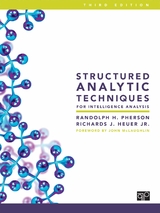
Structured Analytic Techniques for Intelligence Analysis
Cq Press (Verlag)
978-1-4522-4151-7 (ISBN)
- Titel erscheint in neuer Auflage
- Artikel merken
This book showcases fifty-five structured analytic techniques—five new to this edition—that represent the most current best practices in intelligence, law enforcement, homeland security, and business analysis. With much more depth, detail, and utility than existing handbooks, each technique is clearly and systematically explained. Logically organized and richly illustrated, and with spiral binding and tabs that separate techniques into categories, this book is an easy-to-use, comprehensive reference.
Richards J. Heuer Jr. is best known for his book Psychology of Intelligence Analysis and for developing and then guiding automation of the Analysis of Competing Hypotheses (ACH) technique. Both are being used to teach and train intelligence analysts throughout the Intelligence Community and in a growing number of academic programs on intelligence or national security. After retiring from the Central Intelligence Agency (CIA), Mr. Heuer was associated with the Intelligence Community in various roles for more than five decades until his death in August 2018. He has written extensively on personnel security, counterintelligence, deception, and intelligence analysis. Mr. Heuer has a B.A. in philosophy from Williams College and an M.A. in international relations from the University of Southern California. He also pursued graduate studies at the University of California at Berkeley and the University of Michigan. Randolph H. Pherson is president of Pherson Associates, LLC; CEO of Globalytica, LLC; and a founding director of the nonprofit Forum Foundation for Analytic Excellence. He teaches advanced analytic techniques and critical thinking skills to analysts in the government and private sector. Mr. Pherson collaborated with Richards Heuer Jr. in developing and launching use of Analysis of Competing Hypotheses, and he developed several analytic techniques for the CIA’s Sherman Kent School, many of which were incorporated in his Handbook of Analytic Tools and Techniques. He coauthored Critical Thinking for Strategic Intelligence with Katherine Hibbs Pherson, Cases in Intelligence Analysis: Structured Analytic Techniques in Action with Sarah Miller Beebe, and several other guides for analysts on writing, briefing, indicators, and managing the production process. Mr. Pherson completed a twenty-eight-year career in the Intelligence Community in 2000, last serving as National Intelligence Officer (NIO) for Latin America. Previously at the CIA, Mr. Pherson managed the production of intelligence analysis on topics ranging from global instability to Latin America, served on the Inspector General’s staff, and was chief of the CIA’s Strategic Planning and Management Staff. He is the recipient of the Distinguished Intelligence Medal for his service as NIO and the Distinguished Career Intelligence Medal. Mr. Pherson received his B.A. from Dartmouth College and an M.A. in international relations from Yale University.
Chapter 1: Introduction and Overview
1.1Our Vision
1.2Two Types of Thinking
1.3Dealing with Bias
1.4The Role of Structured Analytic Techniques
1.5The Value of Team Analysis
1.6The History of Structured Analytic Techniques
1.7Selection of Techniques for This Book
1.8 Quick Summary of Chapters
Chapter 2: Building a System 2 Taxonomy
2.1Taxonomy of System 2 Methods
2.2Taxonomy of Structured Analytic Techniques
Chapter 3: Choosing the Right Technique
3.1Core Techniques
3.2Five Habits Every Analyst Should Master
3.3One Project, Multiple Techniques
3.4Common Errors in Selecting Techniques
3.5Structured Technique Selection Guide
Chapter 4: Decomposition and Visualization
4.1Getting Started Checklist
4.2AIMS (Audience, Issue, Message, Storyline)
4.3Customer Checklist
4.4Issue Redefinition
4.5Chronologies and Timelines
4.6Sorting
4.7Ranking, Scoring, Prioritizing
4.8Matrices
4.9Venn Analysis
4.10Network Analysis
4.11Mind Maps and Concept Maps
4.12Process Maps and Gantt Charts
Chapter 5: Idea Generation
5.1Structured Brainstorming
5.2Virtual Brainstorming
5.3Nominal Group Technique
5.4Starbursting
5.5Cross-Impact Matrix
5.6Morphological Analysis
5.7Quadrant Crunching™
Chapter 6: Scenarios and Indicators
6.1Scenarios Analysis
6.2Indicators
6.3Indicators Validation
Chapter 7: Hypothesis Generation and Testing
7.1Hypothesis Generation
7.2Diagnostic Reasoning
7.3Analysis of Competing Hypotheses
7.4Argument Mapping
7.5Deception Detection
Chapter 8: Assessment of Cause and Effect
8.1Key Assumptions Check
8.2Structured Analogies
8.3Role Playing
8.4Red Hat Analysis
8.5Outside-In Thinking
Chapter 9: Challenge Analysis
9.1Premortem Analysis
9.2Structured Self-Critique
9.3What If? Analysis
9.4High Impact/Low Probability Analysis
9.5Devil’s Advocacy
9.6Red Team Analysis
9.7Delphi Method
Chapter 10: Conflict Management
10.1Adversarial Collaboration
10.2Structured Debate
Chapter 11: Decision Support
11.1Decision Trees
11.2Decision Matrix
11.3Pros-Cons-Faults-and-Fixes
11.4Force Field Analysis
11.5SWOT Analysis
11.6Impact Matrix
11.7Complexity Manager
Chapter 12: Practitioner’s Guide to Collaboration
12.1Social Networks and Analytic Teams
12.2Dividing the Work
12.3Common Pitfalls with Small Groups
12.4Benefiting from Diversity
12.5Advocacy vs. Objective Inquiry
12.6Leadership and Training
Chapter 13: Validation of Structured Analytic Techniques
13.1Limits of Empirical Analysis
13.2Establishing Face Validity
13.3A Program for Empirical Validation
13.4Recommended Research Program
Chapter 14: The Future of Structured Analytic Techniques
14.1Structuring the Data
14.2Key Drivers
14.3Imagining the Future: 2020
| Erscheint lt. Verlag | 2.7.2014 |
|---|---|
| Verlagsort | Washington |
| Sprache | englisch |
| Maße | 152 x 203 mm |
| Gewicht | 630 g |
| Themenwelt | Sozialwissenschaften ► Politik / Verwaltung ► Europäische / Internationale Politik |
| Sozialwissenschaften ► Politik / Verwaltung ► Staat / Verwaltung | |
| ISBN-10 | 1-4522-4151-1 / 1452241511 |
| ISBN-13 | 978-1-4522-4151-7 / 9781452241517 |
| Zustand | Neuware |
| Haben Sie eine Frage zum Produkt? |
aus dem Bereich



